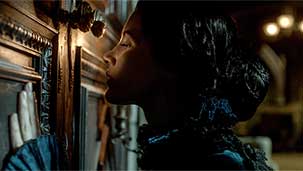If the lyric “every artist is a cannibal” holds any truth at all, it just might explain why you are more than a little rotund. You voraciously consume every sort of genre and then spew out a glorious mess that is neither beast nor fowl. If that seems indelicate and lyrical at the same time it is because that it what your work always seems to reduce to—a kind of lurid poetry that is impossible to ignore.
There is no point in trying to assess Crimson Peak by the usual metrics because its value is located somewhere far to the south of the standard criteria. Plot, consistency in tone, genre fidelity aren’t your primary concerns. Instead your work reads like something the Quay Bros. would produce—after being force fed ether by David Lynch.
Crimson Peak is a film full of heightened performances, fifty two layers of metaphor in each frame, art direction inspired by a mix of Hieronymus Bosch and Durer with a touch of Mary Shelley and the Bronte’s, as well an innocence that sees this all as wondrous rather than grotesque. An elaborate children’s tea party that ends with all the dolls beheaded.
There are a lot of people this film will not impress. On its surface it’s an ornate melodrama punctuated by moments of horrific violence. It’s most overt metaphor is the awakening of the artist—in this case personified by Mia Wasikowska with her usual brilliance—which will irritate the hell out of the less esoterically inclined. It is neither as viscerally affecting as Pan’s Labyrinth nor as filled with childhood melancholy as Devil’s Backbone. What it does have though is a kind of sub rosa power that really doesn’t hit until long after the film is over.
Crimson Peak is what Charlie Kaufman’s Adaptation would look like if it were re-interpreted as a historical romance sprinkled in gore. The narrative evolves as Wasikowska’s character—Edith Cushing—becomes more and more engaged with her own vocation as a writer. Each character that comes into (or in one case tragically and violently leaves) her life changes the tone of the story: the film begins as a stilted, turn-of-the-century period piece set in Buffalo NY and ends as Gothic horror. The finale occurs at a moor-locked, dilapidated manor house surrounded by newly fallen snow—snow that is stained blood red by seeping clay pits.
Subtlety thy name is not Del Toro.
Crimson Peak is, more than anything else, a visually preposterous film. There is so much beauty and excess that it often threatens to overwhelm, but you have an innate capacity to fill the frame exactly up to the line,but never over. Jessica Chastain and Tom Hiddleston manage to make a sibling relationship seem both wrong and undeniably charged. Charlie Hunnam suits his character as well his period costume fit him (which is just fine) and Jim Beaver is starting to rival Sean Bean as the character least likely to make it to the third act. There are whole passages cribbed from Jane Eyre, I half expected Gary Oldman to appear stage left in his Dracula drag and there is an actual elevator to hell that plays a fairly prominent role in the latter half of the film.
And yet somehow, through some bizarre alchemy it seems impossible to pin down, this is a serious film made by an artist at the height of his powers. Crimson Peak has an ambiguous character that is both unsettling and riveting: a cherub disguised as a monster. Either way, it is a film worth the grapple.
Sincerely,

Tim







